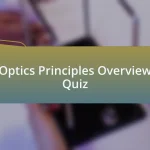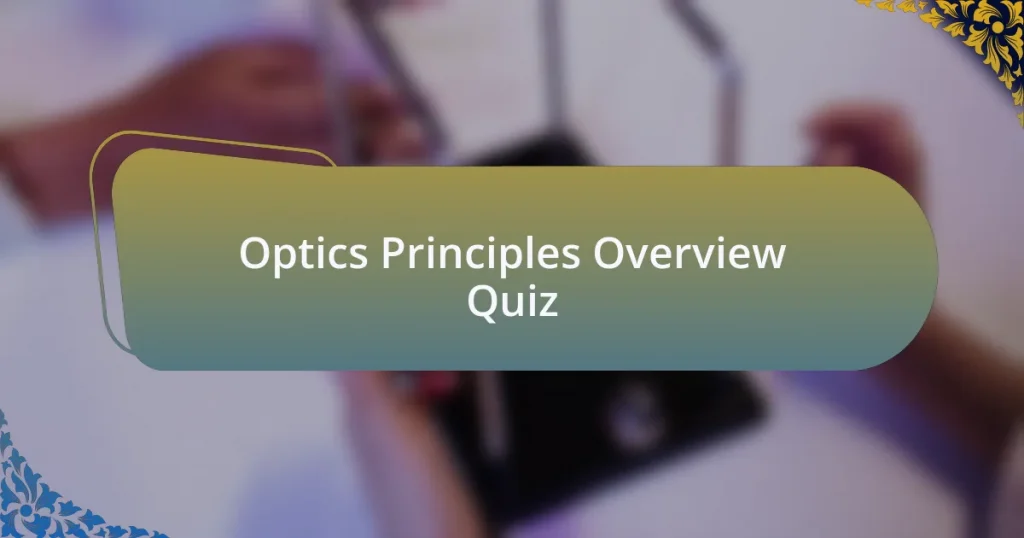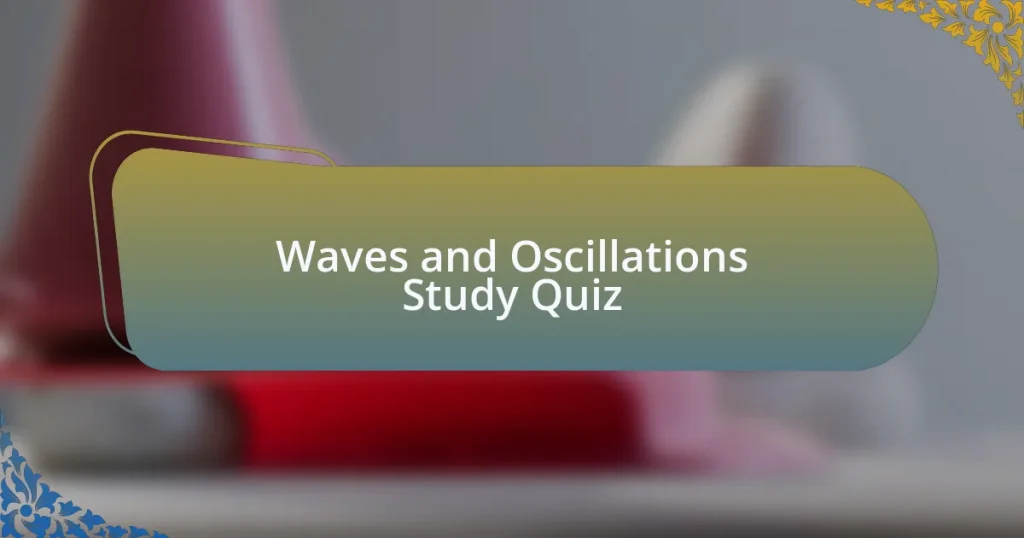Start of Optics Principles Overview Quiz
1. What is the primary focus of optics in physics?
- The primary focus of optics in physics is the study of energy and its transformations.
- The primary focus of optics in physics is the behavior and properties of light, including its interaction with matter and the electromagnetic spectrum.
- The primary focus of optics in physics is the mechanics of moving objects.
- The primary focus of optics in physics is the composition and structure of atoms.
2. Which principle of optics is utilized in the production of corrective eyewear and camera lenses?
- Transmission
- Absorption
- Reflection
- Refraction
3. What phenomenon describes how multiple waves combine to form a resultant wave in optics?
- Diffraction
- Refraction
- Interference
- Dispersion
4. In optics, what principle refers to the bending of light around obstacles or edges?
- Reflection
- Refraction
- Dispersion
- Diffraction
5. Which optical principle governs the path of light when it interacts with objects or media?
- Refraction
- Reflection
- Diffraction
- Dispersion
6. What property of light does optics primarily deal with in physics?
- The absorption of sound waves by light.
- The mass of particles at light speed.
- The speed of light in a vacuum.
- The behavior and interaction of light with matter.
7. What is the main difference between unpolarized light and polarized light?
- Unpolarized light is made of a single color, while polarized light contains multiple colors.
- Unpolarized light travels in straight lines, while polarized light can bend.
- Unpolarized light consists of waves oscillating randomly, while polarized light requires all the waves to oscillate in the same plane.
- Unpolarized light cannot pass through glass, while polarized light can.
8. How do lasers utilize optical amplification?
- Lasers utilize electrical discharge to create intense light beams.
- Lasers utilize chemical reactions to amplify light intensity.
- Lasers utilize optical amplification to produce high-energy, low-divergence light.
- Lasers utilize thermal expansion to generate high-energy light beams.
9. What is the primary function of fiber-optic cables?
- The primary function of fiber-optic cables is to transmit large amounts of data over long distances via pulses of light.
- The primary function of fiber-optic cables is to provide power to devices remotely.
- The primary function of fiber-optic cables is to generate electrical signals for computers.
- The primary function of fiber-optic cables is to store data in a physical medium.
10. How does astronomy benefit from advanced optics?
- Astronomy benefits from advanced optics by enabling the observation of distant celestial bodies with improved image quality and reduced light pollution.
- Astronomy benefits from advanced optics by enhancing terrestrial navigation systems using light signals.
- Astronomy benefits from advanced optics by detecting seismic activity on Earth through light waves.
- Astronomy benefits from advanced optics by predicting weather patterns based on optical data.
11. What career opportunities are available in the field of optics?
- Only physics teaching jobs available.
- Traditional manufacturing roles solely.
- Exclusive art and design professions.
- Research and development, engineering in medicine, communication, and astronomy.
12. What is the main application of Snell`s law in optics?
- Refraction in optical systems.
- Diffraction in wave patterns.
- Reflection in mirrors.
- Interference in light waves.
13. What is the difference between convex and concave lenses?
- Convex lenses diverge light rays, while concave lenses converge light rays.
- Convex lenses have no effect on light rays, while concave lenses amplify them.
- Convex lenses converge light rays, while concave lenses diverge light rays.
- Convex lenses both converge and diverge light rays equally.
14. Which lens is used by magnifying glasses?
- Convex lenses are used by magnifying glasses.
- Cylindrical lenses are used by magnifying glasses.
- Planar lenses are used by magnifying glasses.
- Concave lenses are used by magnifying glasses.
15. Which kind of electromagnetic radiation can human eyes see?
- Ultraviolet light
- Radio waves
- Infrared light
- Visible light
16. Why do bananas appear yellow?
- Bananas appear yellow due to the presence of vitamin C in them.
- Bananas appear yellow because they are ripening and producing sugar.
- Bananas appear yellow because they reflect yellow light and absorb all other light.
- Bananas appear yellow because of the natural wax coating on their skin.
17. What do you call a material that does not transmit light?
- Reflective
- Opaque
- Transparent
- Translucent
18. What is the separation of light into its seven different constituent colors called?
- Dispersion
- Refraction
- Reflection
- Diffraction
19. What is the property of light traveling in a straight line called?
- Straight-line motion
- Linear dispersion
- Rectilinear propagation
- Uniform trajectory
20. How do objects with a higher refractive index affect light?
- Objects with a higher refractive index cause light to bend more as it passes through them.
- Objects with a higher refractive index distort light to create a rainbow effect.
- Objects with a higher refractive index make light disappear completely.
- Objects with a higher refractive index cause light to pass straight through without bending.
21. What kind of image is formed by the actual intersection of light rays?
- Reflected image
- Virtual image
- Distorted image
- Real image
22. What branch of physical science studies light`s behavior and properties, as well as its interaction with matter?
- Optics
- Electromagnetism
- Kinematics
- Thermodynamics
23. How do visible, ultraviolet, and infrared light behave?
- Visible light is perceivable by the human eye, ultraviolet light is not perceivable but can cause reactions, and infrared light is not perceivable but can cause heating.
- Visible light is the only type that can be heard, while ultraviolet and infrared light can only be felt.
- Ultraviolet light is visible to the human eye, while visible light cannot be detected by it.
- All three types of light can be seen and felt equally by humans.
24. What is Newton`s view about light?
- Newton thought that light was only a wave phenomenon.
- Newton claimed that light has no physical substance.
- Newton stated that light is colorless and has no properties.
- Newton believed that light was composed of material corpuscles moving in motion.
25. What is the essential tool for diagnosing diabetes and other diseases using light?
- Thermodynamics
- Quantum entanglement
- Optical spectroscopy
- Gravitational waves
26. How does photonics play a role in drug development and quality control?
- Photonics assists in drug development through manual inspection of tablets.
- Photonics helps in drug development by increasing the temperature of materials.
- Photonics contributes to drug development by changing the chemical composition of drugs.
- Photonics plays a significant role in drug development and quality control by providing advanced imaging tools and diagnostics.
27. What is the primary function of the cladding in fiber-optic cables?
- To protect the core from damage.
- To reduce the diameter of the cable.
- To maintain total internal reflection (TIR).
- To increase the signal strength.
28. What is cladding loss in fiber-optic cables?
- Cladding loss is caused by impurities in the glass core of the fiber-optic cable.
- Cladding loss is the result of external damage to the fiber-optic cable`s jacket.
- Cladding loss in fiber-optic cables refers to the reduction in signal strength due to the interaction between the core and cladding.
- Cladding loss occurs when light escapes from the core into the surrounding air.
29. What is the typical loss rate for common multimode step index fibers?
- 25%
- 3%
- 50%
- 17%
30. How does the thickness of the cladding affect cladding loss?
- The thickness of the cladding can affect cladding loss, with thicker claddings generally resulting in lower loss rates.
- The thickness of the cladding only impacts core diameter, not loss rates.
- The thickness of the cladding has no effect on cladding loss rates at all.
- Thicker claddings always lead to higher cladding loss rates.
Congratulations on Completing the Quiz!
You’ve successfully completed the quiz on ‘Optics Principles Overview.’ This is a fantastic achievement that reflects your dedication to understanding the fundamentals of optics. Throughout the quiz, you likely encountered key concepts like the behavior of light, reflection, refraction, and the properties of lenses and mirrors. Each question was designed to challenge your understanding and enhance your physics knowledge.
As you navigated through the quiz, you may have discovered how these principles apply to real-world phenomena. Perhaps you learned how prisms separate light into colors or how magnifying glasses work. These insights not only deepen your appreciation for physics but also build a solid foundation for further studies. Engaging with these concepts is an essential step in mastering optics.
We encourage you to continue your learning journey! Check out the next section on this page for more in-depth information about ‘Optics Principles Overview.’ This resource will provide expanded explanations, illustrations, and examples that can enrich your understanding. As you prepare for your physics tests, remember that a strong grasp of optics is invaluable. Happy studying!
Optics Principles Overview
Introduction to Optics
Optics is the branch of physics that deals with the behavior and properties of light. It encompasses the study of how light interacts with matter, including reflection, refraction, and dispersion. Understanding optics is essential for many applications, including lenses, mirrors, and optical instruments. This foundational knowledge is crucial for anyone preparing for physics tests, as principles of optics frequently appear in exam questions.
Reflection and Refraction of Light
Reflection occurs when light bounces off a surface. The angle of incidence is equal to the angle of reflection. Refraction, on the other hand, is the bending of light as it passes through different media, defined by Snell’s Law. This principle states that the product of the index of refraction and the sine of the angle of incidence is constant. Mastering these concepts is vital for physics tests, which often include calculations involving angles and the indices of refraction.
Lenses and Optical Instruments
Lenses are instruments designed to manipulate light through refraction. There are two primary types: convex (converging) and concave (diverging). Convex lenses focus light to a point, while concave lenses spread light out. Optical instruments, like telescopes and microscopes, utilize these lenses to enhance images. Knowledge of how lenses work and their specific applications is essential for understanding complex optical systems in physics.
Wave Properties of Light
Light exhibits wave-like properties, described by the wave model of light. This includes phenomena such as interference, diffraction, and polarization. These concepts explain how light behaves under various conditions, influencing its interactions with materials. In physics test preparation, understanding these wave phenomena helps anticipate question types and problem-solving strategies related to light behavior and its applications.
Optical Phenomena in Nature
Optical phenomena, such as rainbows and mirages, result from the interaction of light with atmospheric conditions. For example, a rainbow forms through the refraction and dispersion of light in water droplets. Understanding these natural occurrences provides a concrete application of optics principles. Physics tests often include questions that apply these phenomena to real-world scenarios, reinforcing the importance of this knowledge.
What are the basic principles of optics?
The basic principles of optics include reflection, refraction, dispersion, and diffraction. Reflection occurs when light bounces off a surface. Refraction is the bending of light as it passes through different mediums. Dispersion involves the separation of light into its constituent colors, as seen in a prism. Diffraction refers to the bending of light waves around obstacles. These principles are foundational in understanding how light interacts with different materials.
How do lenses work in optics?
Lenses work by bending light rays through refraction. A convex lens converges light rays to a focal point, while a concave lens diverges them. The curvature of the lens defines its focal length, which determines where images form. The behavior of light through lenses can be described using the lens maker’s equation, which relates the focal length to the lens’ shape and the materials used.
Where is optics applied in everyday life?
Optics is applied in various everyday devices such as glasses, cameras, and microscopes. Glasses use lenses to correct vision by refracting light to focus it correctly on the retina. Cameras capture images through a system of lenses that direct light onto a sensor or film. Microscopes utilize optics to magnify small objects, allowing detailed examination. These applications showcase the importance of optics in enhancing human perception and interaction with the world.
When was the field of optics established?
The field of optics was established in ancient times, with significant contributions from Greek philosophers like Euclid and Ptolemy around 300 BCE to 100 CE. The formulation of geometric optics developed further during the Islamic Golden Age, with Alhazen (Ibn al-Haytham) formally recognizing the importance of experimentation. Modern optics, particularly wave and quantum optics, expanded significantly in the 19th and 20th centuries, reflecting advancements in physics and technology.
Who are the key figures in the development of optics?
Key figures in the development of optics include Euclid, who wrote “Optics,” and Alhazen, known as the “father of optics” for his work on light and vision. Johannes Kepler contributed with his laws of planetary motion and theories of perspective. Isaac Newton advanced optics with his work on the nature of light and color, particularly demonstrated in his experiments with prisms. These individuals laid the groundwork for many modern optical theories and technologies.













